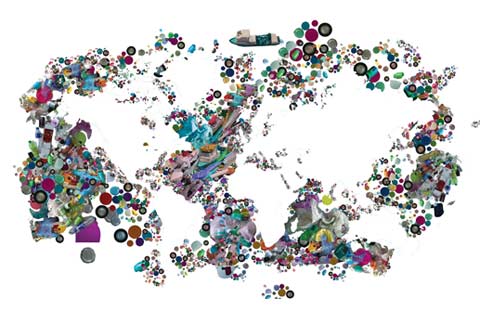Layered oceans suspected on Jupiter moon
Updated: 2014-05-07 09:10
By Will Dunham in Washington (China Daily)
|
|||||||||||
Steve Vance, an astrobiologist at NASA's Jet Propulsion Laboratory in California, says the arrangement might be like this: at the top, a layer of ice on the moon's surface, with a layer of water below that, then a second layer of ice, another layer of water underneath that, then a third layer of ice, with a final layer of water at the bottom above the rocky seafloor.
"That would make it the largest club sandwich in the solar system," Vance says.
Ganymede boasts a lot of water, perhaps 25 times the volume of Earth's oceans. Its oceans are estimated to be about 800 km deep.
With enough salt, liquid water on Ganymede could become so dense that it sinks to the very bottom, the researchers say. That means water may be sloshing on top of rock, a situation that may foster conditions suitable for the development of microbial life.
Some scientists suspect that life first formed on Earth in bubbling thermal vents on the ocean floor.
"Our understanding of how life came about on Earth involves the interaction between water and rock. This (research)provides a stronger possibility for those kinds of interactions to take place on Ganymede," adds Vance, whose study was published in the journal Planetary and Space Science.
Ganymede is one of five moons in the solar system thought to have oceans hidden below icy surfaces. Two other moons, Europa and Callisto, orbit the big gas planet Jupiter. The moons Titan and Enceladus circle the ringed gas planet Saturn.
"We're providing a more realistic view into ocean structure in Ganymede's interior. We're showing that the salinity has a tangible effect on the ocean, " Vance says.
Reuters
Related Stories
By the light of the crescent moon 2013-11-24 07:05
Special: Moon · Cakes · Tea 2013-09-16 17:05
23rd Autumn Moon Festival in San Francisco 2013-09-16 10:23
Scientist focuses on smog and micro-world 2014-04-12 11:09
Chinese, German scientists discover world’s oldest cheese 2014-03-12 14:24
Today's Top News
Ukraine moves special forces to Odessa
Slovenian PM resigns
Disclosure of military secrets becoming bigger risk
China, AU to deepen co-op
UN hosts China Shanxi Food Festival
Chinese Parents: For some, it's 'Harvard, Harvard'
Japanese writer Junichi Watanabe dies at 80
Vietnamese veteran reminisces victory in the Battle of Dien Bien Phu
Hot Topics
Lunar probe , China growth forecasts, Emission rules get tougher, China seen through 'colored lens', International board,
Editor's Picks

|

|

|

|

|

|





